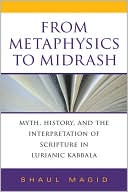List Books » From Metaphysics to Midrash: Myth, History, and the Interpretation of Scripture in Lurianic Kabbala
Category Books
- Fiction Books & Literature
- Graphic Novels
- Horror
- Mystery & Crime
- Poetry
- Romance Books
- Science Fiction & Fantasy
- Thrillers
- Westerns
- Ages 0-2
- Ages 3-5
- Ages 6-8
- Ages 9-12
- Teens
- Children's Books
- African Americans
- Antiques & Collectibles
- Art, Architecture & Photography
- Bibles & Bible Studies
- Biography
- Business Books
- Christianity
- Computer Books & Technology Books
- Cookbooks, Food & Wine
- Crafts & Hobbies Books
- Education & Teaching
- Engineering
- Entertainment
- Foreign Languages
- Game Books
- Gay & Lesbian
- Health Books, Diet & Fitness Books
- History
- Home & Garden
- Humor Books
- Judaism & Judaica
- Law
- Medical Books
- New Age & Spirituality
- Nonfiction
- Parenting & Family
- Pets
- Philosophy
- Political Books & Current Events Books
- Psychology & Psychotherapy
- Reference
- Religion Books
- Science & Nature
- Self Improvement
- Sex & Relationships
- Social Sciences
- Sports & Adventure
- Study Guides & Test Prep
- Travel
- True Crime
- Weddings
- Women's Studies
From Metaphysics to Midrash: Myth, History, and the Interpretation of Scripture in Lurianic Kabbala »

Authors: Shaul Magid
ISBN-13: 9780253350886, ISBN-10: 0253350883
Format: Hardcover
Publisher: Indiana University Press
Date Published: June 2008
Edition: (Non-applicable)
Author Biography: Shaul Magid
Shaul Magid is Jay and Jeannie Schottenstein Chair in Jewish Studies and Professor in Religious Studies at Indiana University, Bloomington.
Book Synopsis
In From Metaphysics to Midrash, Shaul Magid explores the exegetical tradition of Isaac Luria and his followers within the historical context in 16th-century Safed, a unique community that brought practitioners of Judaism, Christianity, and Islam into close contact with one another. Luria's scripture became a theater in which kabbalists redrew boundaries of difference in areas of ethnicity, gender, and the human relation to the divine. Magid investigates how cultural influences altered scriptural exegesis of Lurianic Kabbala in its philosophical, hermeneutical, and historical perspectives. He suggests that Luria and his followers were far from cloistered. They used their considerable skills to weigh in on important matters of the day, offering, at times, some surprising solutions to perennial theological problems.
Table of Contents
Introduction Kabbala, New Historicism, and the Question of Boundaries 1
The Lurianic Myth: A Playbill 16
1 Genesis: "And Adam's Sin Was (Very) Great": Original Sin in Lurianic Exegesis 34
2 Exodus: The "Other" Israel: The Erev Rav (Mixed Multitude) as Conversos 75
3 Leviticus: The Sin of Becoming a Woman: Male Homosexuality and the Castration Complex 111
4 Numbers: Balaam, Moses, and the Prophecy of the "Other": A Lurianic Vision for the Erasure of Difference 143
5 Deuteronomy: The Human and/as God: Divine Incarnation and the "Image of God" 196
Conclusion 222
Notes 229
Bibliography 321
Index 347
Subjects
 Judaism & Judaica
Judaism & Judaica  Mysticism & Kabbalah - Judaism
Mysticism & Kabbalah - JudaismChristianity
 All Religion
All Religion  General & Miscellaneous Religion
General & Miscellaneous ReligionJudaism & Judaica
 Mysticism & Kabbalah - Judaism
Mysticism & Kabbalah - Judaism  Kabbalah -> History
Kabbalah -> HistoryNonfiction
 Philosophy
Philosophy  Major Branches of Philosophical Study
Major Branches of Philosophical StudyPhilosophy
 Major Branches of Philosophical Study
Major Branches of Philosophical Study  Metaphysics
MetaphysicsReligion Books
 Judaism & Judaica
Judaism & Judaica  Mysticism & Kabbalah - Judaism
Mysticism & Kabbalah - JudaismReligion Books
 All Religion
All Religion  General & Miscellaneous Religion
General & Miscellaneous ReligionChristianity
 Christianity
Christianity  All Religion
All ReligionNonfiction
 Religion
Religion  All Religion
All ReligionReligion Books
 Christianity
Christianity  All Religion
All Religion
